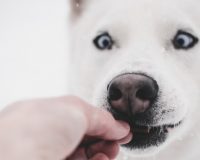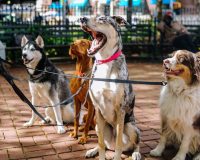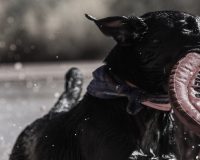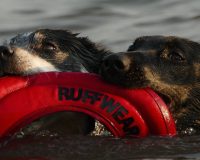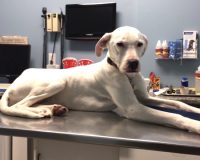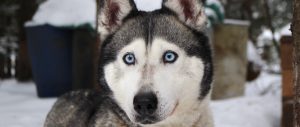
The Rescue Process | How it Works
By Jeanne D’Barc, Rescue Volunteer | Sentience | Rescue & Rescue Dogs | August 6, 2018
None are more deserving than animals are for a second chance and a happier life. Dogs are rescued, from all over the globe, by Canadian organizations.
Interested in getting a Rescue but don’t know where to start? Choosing a reputable rescue will help immeasurably. Or you can go straight to a national matchmaking service who will pair you with a Rescue pup. Ashley Baylen is a Certified Trainer, working with families across Canada. She has a Muttmaking service, which finds the perfect pup from a quality Rescue and matches him/her to the right family, ensuring optimal fit.
Bar none, there is a lot to know. Before thinking about adopting a Rescue, be advised that there are challenges that come with the dogs which must be expected and prepared for. Getting all the facts first helps in the decision of whether a rescue is the right decision for you. Decide with the mind, not the heart. It will take a Trainer, tremendous commitment to the pup’s well being, and financial stability.
Shelters, Sanctuaries and Humane Societies across Canada run animal adoptions and most potential owners have a good idea how it works and who to call.
Here, we will give focus on the Rescues that are done internationally, since this information is not widely known. It does provide some context as to why these pups require so much in extra services and care.
What are Rescued Pups like?
Some make an easy transition and others need more time. Generally speaking, almost all come with fear, the severity depending on the conditions they came from and their own temperaments. Like humans, one trauma can lead to lifelong issues, or none for the more resilient.
Some rescues come here as pack animals with positive and negative human experiences. They might be perfectly adjusted to pack rules, with little or no adjustment to human rules. They are experienced, street smart, and most particularly, they are resilient survivors, which is a big plus. The pups selected for rescue are resilient to change, outgoing with humans, and tend to be younger for better training success, as a rule. There are exceptions, however, depending on the quality of the organization you’re dealing with.
Who is Approved to Adopt a Rescue?
Many find that adopting a Rescue is complicated. It can be, and should be. The adoption process is based on whether the dog will thrive in the environment he/she is placed in. Many in the rescue process worked tirelessly to bring the dog into better circumstances, so the collective commitment is to place the pup in optimal circumstances.
Families that are not approved most often have young children, other animals and person(s) with allergies in the house. Males are sometimes refused—though this is judged on a per-dog basis and based on whether a pup is reactive to men, given how the dog was treated in their home country. In these cases, risks aren’t taken: the comfort and safety of the dog and the family is paramount.
Lower income households are not favoured for adoption for fear that a dog’s needs cannot be comfortably met, financially. Dogs are expensive. Dogs that require trainers, even more so.
Ashley Baylen is a Certified Trainer, working with families across Canada. She has a Muttmaking service, which finds the perfect pup from a quality Rescue and matches him/her to the right family, ensuring optimal fit.
What’s Reasonable to Expect if Approved? The Rescue Backgrounder
The majority of arriving dogs have been put through a fairly vigorous rescue process. Their human contact rose sharply and their freedoms are gone. Life is upside down. As a result, most are frightful. At the first opportunity, many will bolt to freedom, given the chance. Be prepared to grow the bond and keep the pup on leash for a good, long while.
The pup is smart and survival-savvy, so do not feel sorry for him/her. Pups sense a pity dynamic and this will not strengthen trust or the human/canine bond. It will stunt their confidence.
The very first thing any adopting Owner should do is hire a Certified Trainer. A Trainer will assess the pup and develop a customized, strategic course to equip Owners with the skills required to redirect and/or recondition fears and behaviours that require mitigation. Love is not enough. Hire a Trainer.
This will get you through the first year or two. What’s next? Then the pup’s real personality will come out. Hire the Certified Trainer again. This is an expectation every owner should have.
The rescue community does not keep statistics on how many Rescues are surrendered. They simply don’t know, given there is no centralized reporting and there are scores of ways to surrender. The community is aware, however, that a significant number of Rescues are surrendered because overwhelmed Owners were ill-prepared to handle the demands a Rescue represents.
How do Rescue Organizations Work?
Successful rescues are finely tuned, requiring no less than 12 pairs of hands, plus complex coordination on both sides, for each dog rescued. The circumstances that rescue dogs come from vary widely, but the most popular are abusive, abandonment, surrender and stray conditions.
The Rescue Process: Country of Origin
In the dog’s home country, pups in need are identified and removed from their current situation by rescue personnel. The pup is cleaned, de-parasited, medically and behaviourally assessed and veterinary treatment begins. If necessary, the dog is quarantined to ensure they receive treatment for contagious medical conditions, when present.
When and if possible, rescue staff begin socializing, house training, collar and leash training the dog. Depending on the pup’s success within each of these stages, it is then determined whether a pup is chosen for rescue.
If chosen and all medical requirements are met, the Rescue initiates arrangements for receiving the pup into its new home country and coordinates transport.
Feral dogs are not candidates for rescue, as they do not adjust to human care.
Canada-Bound: Dogs Arrive in Great Condition and with Papers
The rescue pup will be spayed/neutered and fully healed before flying, with an escort, to Canada. On arrival, completed paperwork must accompany the dog.
Request Your Copy of this Paperwork
• Health certificate with veterinary stamp
• If the dog is a personal rescue (ie: between friends/family), a letter is prepared for the Canadian Food Inspection Agency (CFIA) and the Canada Border Services Agency (CBSA) indicating the history and health status of the dog
• If the dog arrives in Canada through the assistance of a Rescue entity, then completed commercial paperwork, including their business number and the value of the animal is prepared
• The pup is then escorted to the receiving Rescue who then arranges a foster home to continue training the pup.


